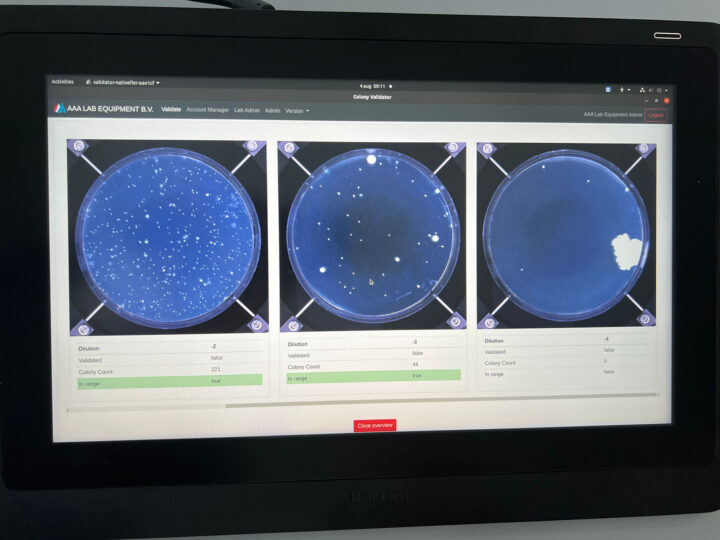Meet "Iris", our fast, automatic colony counter!
Totally designed, created, programmed and build “in house” at AAA Lab Equipment B.V.
The solutions contain the latest robotics and machine learning technologies
- Reliable
- Consistent
- Compact
- Expand
- Future proof
- Reflectionless
- Good support
- Can be connected to your LIMS
How Iris works
Iris is easy-to-use, you don’t have to rack your brains and you don’t have to count anything. It’s just a matter of the right training.
Watch how easy it is here, start the video >>
For High-throughput labs together with the “Irina”
Would you like more information? email Peter Krul
Scan
In brief: if an analyst can identify a colony on an image within 1.5 seconds, we can also teach this to a neural network. This also applies to the distinction between particles/dirt and colonies, and even the reflections of colonies can be recognised as such. A neural network is therefore trained using the knowledge and experience of the analyst. It’s just that a Neural Network is many times quicker.
If you are seriously interested, convince yourself with an introduction process.
At the start of this project, two Agar/micro-organism combinations are selected, on which we will train two neural networks. A number of representative Petri dishes are then selected to adjust the camera and lighting. We can also check to see if existing neural networks are available to support annotation. All of these settings are saved in the TrainingSet Creator as two different tests. Using the TrainingSet Creator, you can create images and annotate them. We oversee this annotation remotely and inspect the quality of the annotations and the balance and size of the dataset in its entirety. After completion, we train a new neural network on the basis of this dataset. We will upload this trained neural network for you, to evaluate in the Validation web app.
This has been specifically developed to create datasets for the training of neural networks. You use this application to create the images and install annotations with or without the aid of an existing neural network. You can take photos in bulk so that they can be annotated at a later date, or individually, so that you can consult the Petri dish during annotation.
This web application (intranet) is easy to access from your network via any web browser. Simply log in with your user name and password. Select which test/analysis you want to use, enter a code by typing or scanning a barcode. Create an image and annotate directly, or create a set of images to annotate. State the false positives and false negatives on the validation PC and validate the image. Because this is a web application, it doesn’t matter where the validation takes place. All of the information is then made available in a zip file on the FTP server, for example for LIMS (in various file formats).
‘iris’ solo
Intended for laboratories with small volumes or as a replacement for traditional automatic colony counters. Manual loading of Petri dishes.
Camera, A.I. server, FTP-server (LIMS data) and Validation web app For 90mm and 60mm petri dishes and Petri film‘iris’ desktop
Currently under development
All-round and flexible, intended for laboratories with average volumes.
An industrial robot for the loading and scanning of Petri dishes.
Robot, Camera, A.I. Server, FTP-server (LIMS data) and Validation web ap
For 150 mm, 90 mm and 60 mm petri dishes, also with ‘twist lock’ covers and Petri-film.Irina platform with integral ‘iris’
Intended for laboratories with large volumes.
Irina platform for the processing of 540 petri dishes in approximately 90 minutes. Irina platform, Camera, AI Server, FTP-server (LIMS data) and Validation web app Only for 90 mm dishes.
Video's
In this video you can see you can count the number of colonies present in a petri dish in a few seconds using our revolutionary artificial intelligence (AI) colony counter “Iris”.






